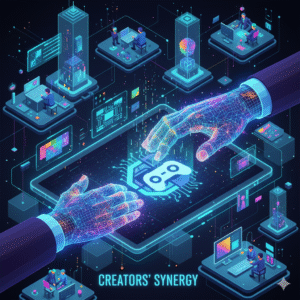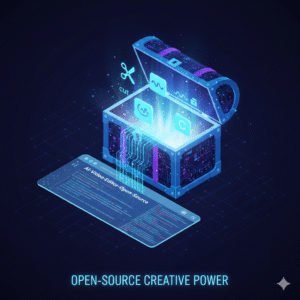Meet Maya. Maya is a fantastic graphic designer. She used to spend hours sketching, brainstorming, and mixing colors to create unique logos for her clients. Then, she discovered AI image generators. At first, it was magic. She could type “a minimalist logo for a coffee shop, fox-themed, art deco style,” and poof—ten options appeared. Her workflow became faster, and her clients were happy. (Prompt Dependency ABA)
But soon, Maya noticed something scary. When she sat down with a blank piece of paper, her mind was… blank. She couldn’t start without a prompt. She felt like she’d forgotten how to be creative on her own. Maya was experiencing Prompt Dependency.
If this sounds familiar, you’re not alone. We’ve all been given this amazing new toolbox, but we’re starting to feel like the tools are using us. The good news? There’s a way out. We’re going to borrow a method from psychology called Applied Behavior Analysis (ABA).
Don’t worry, it sounds complicated, but it’s simple. Think of ABA as a way to understand and change habits. We’re going to use its principles to fix our “prompt dependency” problem and turn AI from a crutch back into a powerful collaborator.
What Is This “Prompt Dependency” Thing, Anyway?
Before we can fix it, let’s understand the problem.
Imagine you’re learning to ride a bike. At first, you use training wheels. They’re super helpful! They stop you from falling and let you get used to steering and pedaling. But what happens if you never take the training wheels off? You’ll be able to get around, sure, but you’ll never really learn to balance. You’ll always be limited by them.
Prompt Dependency is the “training wheels” of creativity. It’s when you become so reliant on AI tools to generate ideas, write drafts, or create images that your own creative “muscles” get weak. You start to fear the blank page because you’ve forgotten how to fill it yourself.
This is a huge problem for AI and creativity. Instead of the AI being your co-pilot, it becomes the pilot, and you’re just a passenger. This can lead to generic, “same-y” content that lacks your unique voice and spark.
So, What’s This “ABA” Part?
Applied Behavior Analysis (ABA) is a scientific approach to understanding behavior. At its core, it’s about figuring out why we do what we do and then using simple steps to build good habits and break bad ones.
Think about how you’d train a puppy. You don’t just expect it to know “sit.” And, You guide it, and when it sits, you give it a treat (a positive reward). You start with small steps and build up.
We can use these same ideas to retrain our brains. Our “bad habit” is running to AI for every little thing. The “reward” is the instant, easy answer. The Prompt Dependency ABA method is about changing this pattern. It’s about creating a new, healthier human-AI collaboration for creators that puts you back in charge.
How to Use the Prompt Dependency ABA Method to Reclaim Your Spark
Let’s break down this process into simple, actionable steps. We’ll focus on three main ABA ideas: Shaping, Fading, and Chaining.
1. Shaping: Start Small and Build Your Way Up (Prompt Dependency ABA)
Shaping is about rewarding small steps toward a big goal. Instead of asking AI to do the entire task, ask it to help with just one tiny piece.
Let’s say you need to write a blog post (like this one!).
- Old Way (Prompt Dependency): “Write me a 1,000-word blog post about the future of marketing.” You get a generic article that sounds like a robot wrote it.
- New Way (ABA Shaping):
- You (Human): First, you do a 10-minute “brain dump.” Write down every messy idea you have. (e.g., AI is changing ads, social media is important, what about email?, TikTok is new…)
- You (Human): You group these ideas into 3-4 main themes.
- AI (Collaborator): Now, you give the AI a specific task. “Take these 3 themes [paste themes] and suggest 5 catchy headlines for a blog post aimed at small business owners.”
- You (Human): You pick a headline you like and write the first draft. You are in control.
- AI (Collaborator): You give the AI your draft and ask, “Can you check this for passive voice and suggest stronger verbs?”
See the difference? This approach builds true human-AI collaboration for creators. You are the architect; the AI is just your very fast assistant.
2. Fading: Gradually Taking the Training Wheels Off (Prompt Dependency ABA)
Fading is exactly what it sounds like: slowly removing the help until you can do it yourself. This is how you cure prompt dependency.
Start by giving the AI very detailed, restrictive prompts. Then, with each new project, make your prompts less specific. This forces your brain to fill in the creative gaps.
Example for a Designer:
- Week 1 (Heavy Prompts): “Create a photorealistic image of a 1950s-style diner at night, neon lights reflecting on a wet street, a classic red car parked outside, viewed from a low angle.” (Very specific, AI does most of the work).
- Week 2 (Fading): “Create an image of a retro diner at night with a moody, film-noir feel.” (You’re giving the AI more creative freedom, but still guiding it).
- Week 3 (Minimal Prompt): “Concept for a retro diner logo.” (Now, the AI gives you ideas, and you do the real design work).
This process gradually rebuilds your confidence. You’re teaching yourself that you don’t need the perfect, 100-word prompt to get a great result. Your own creativity is the main ingredient again.
3. Chaining: Connecting Small Steps for a Big Win
Chaining is about linking simple tasks together to create a complex and effective creative workflow automation. Instead of one giant, overwhelming task (“make a marketing campaign”), you break it into a chain of small, manageable steps.
Here’s a sample “chain” for a content creator:
- Step 1 (Human): Identify the core problem your audience has. (e.g., “My audience struggles with feeling uninspired.”)
- Step 2 (AI): “Act as a market researcher. Give me 10 common reasons creators feel uninspired, citing sources if possible.”
- Step 3 (Human): Use that research to create a “skeleton” outline for a video script.
- Step 4 (AI): “Review this outline. Suggest one ‘hook’ (a catchy opening line) and one ‘call to action’ (what I want the viewer to do at the end).”
- Step 5 (Human): Write the full script, film the video, and edit it. Your voice, your face, your ideas.
- Step 6 (AI): “Here is my final video transcript. Please generate 3 tweets and a short email newsletter summary based on it.”
This isn’t prompt dependency; this is smart creative workflow automation. You’re automating the boring parts (like reformatting) and using the AI as a research assistant, freeing you up for the most important part: being creative.
Real-World Examples: Who is Using AI as a Collaborator? (Prompt Dependency ABA)
This human-AI collaboration for creators model isn’t just a theory. Smart professionals are already doing it.
- The Marketing Agency: A small marketing firm, “BrightSpark,” was spending 80% of its time writing basic social media updates for clients. By building an AI workflow (chaining), they now feed the AI their client’s “brand voice” guide and a list of topics for the week. The AI generates first drafts, which a human editor then reviews and personalizes in 20% of the time. This freed up their team to focus on big-picture strategy and creative campaign ideas—the parts that actually grow their clients’ businesses.
- The Indie Game Developer: A solo developer, “Starlight Games,” needed hundreds of item descriptions for their new RPG. Writing them all by hand was burning them out (a clear path to prompt dependency). Instead, they created a template:
[Item Name] is a [Weapon/Armor] that offers [Stat] and was once wielded by [Famous Hero].They fed this template to an AI with a list of items, generating hundreds of descriptions in minutes. They then reviewed and tweaked them, saving weeks of work while retaining full creative control. - The Corporate Training Team: A training department at a large tech company needed to create quizzes for new software. Instead of writing questions from scratch, they fed the AI the software’s technical manuals (a lot of text) and prompted it: “Based on the attached manual, generate 20 multiple-choice questions about the ‘XYZ’ feature.” As reported by companies like McKinsey, this use of AI to synthesize large data sets is a massive productivity booster, not a creativity killer.
Your Toolkit for Beating Prompt Dependency (Prompt Dependency ABA)
Ready to change your habits? Here are some tools and final tips to help you build a healthy human-AI collaboration system.
Top Tools for Creative Collaboration
- Notion AI: This is a great example of creative workflow automation. Because the AI is built directly into your notes and documents, it’s easier to use it as a helper. You can write a paragraph, then just hit a key to ask the AI to “make this sound more professional” or “find the key takeaways.”
- Grammarly: It’s more than a spell-checker. Its “tone” and “clarity” suggestions are a perfect example of ABA. It doesn’t write for you; it gives you small, positive suggestions (rewards) to improve the writing you’ve already done.
- ChatGPT / Claude / Gemini: These are the big “Large Language Models” (LLMs). The trick here is to treat them like a brainstorming partner, not an author. Use them to debate ideas, get a different perspective, or summarize complex research. Never copy and paste without a complete human rewrite.
Final Tips to Stay in Control
- Never Use the First Output: Make it a rule. Whatever the AI gives you, your job is to change at least 30% of it. This forces you to add your own value.
- Create an “Idea-First” Zone: Have a physical notebook or a simple text file where you must write down your first ideas before you’re allowed to open an AI tool.
- Focus on Better Questions, Not Perfect Prompts: Stop trying to write the “perfect” prompt that will do all the work. Instead, focus on asking smarter questions that force the AI to be a better assistant. Instead of “Write an article,” try “What are the three strongest arguments against my topic?”
The Future is a Partnership, Not a Crutch (Prompt Dependency ABA)
The fear of AI and creativity being at odds is understandable. It feels like this new technology is so fast, so smart, that our own human spark might get lost.
But that’s only true if we let it. Prompt dependency is a choice, and you can choose a different path. By applying the simple principles of ABA—shaping your workflow, fading your reliance on prompts, and chaining your tasks—you can move from being an AI operator to an AI director.
The goal isn’t to get rid of AI. The goal is to build a powerful human-AI collaboration that amplifies your unique voice, supercharges your productivity, and, most importantly, keeps you in the creative driver’s seat.
So, the next time you face a blank page, don’t just reach for the AI. Start with your own idea, however small. That’s the first step to breaking free.
Prompt Careers: The Secret Job of the Future You Can Start Today
What’s one small task you could take back from AI this week to start rebuilding your creative muscle? Share your thoughts in the comments below!



